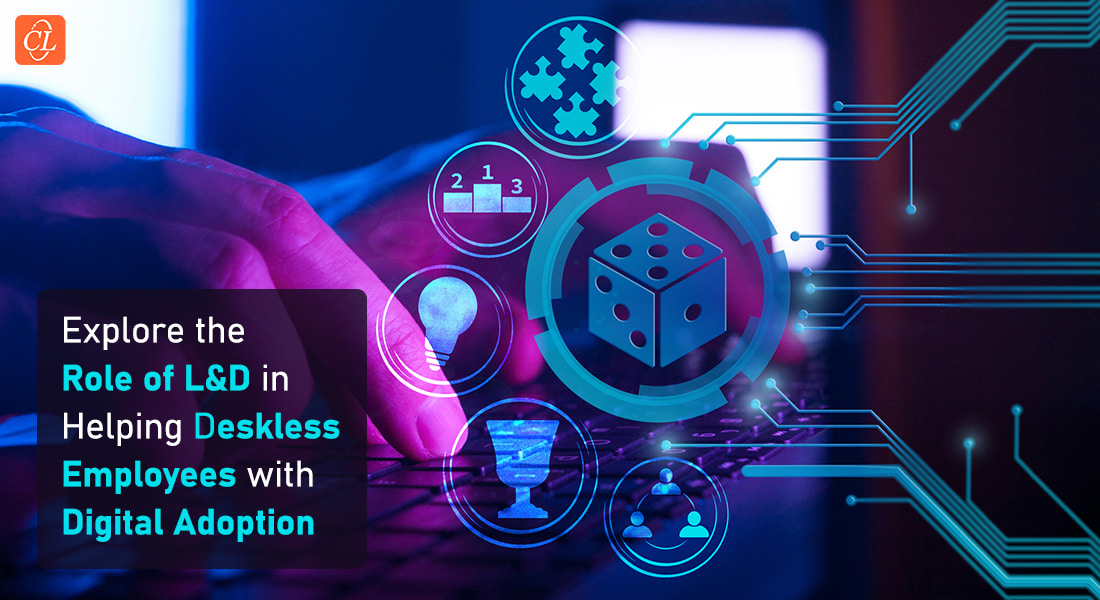How L&D Teams Can Help Deskless Employees with Digital Adoption

The Covid-19 pandemic has disrupted business as usual in almost every industry in the market. It has forced businesses to change several aspects of their business operations, including their training programs. With remote and hybrid work models becoming normal, there’s been a much-needed proliferation of innovative solutions to maintain or improve operational efficiency, employee productivity, and bottom line. Unfortunately, many learning and development teams have fallen behind when it comes to finding new learning tools and technologies tailored to help the deskless workforce.
Digital Adoption of the Deskless Workforce Seems to be a Concern in Present Times
Here’s How Your L&D Team Can Help:
- Designing and delivering mobile-friendly microlearning courses
- Providing gamified learning experiences
- Using augmented and virtual reality training courses
Read on to explore more ways.
The current deskless workforce comprises nearly 2.7 billion people working in the non-traditional office or outdoor environments. Since these workers typically don’t have the same tools and facilities as their in-office or remote counterparts, L&D teams are constantly looking for new approaches to improve their digital literacy and capabilities so they can adapt to new processes, solutions, and strategies.
In this post, we’ll share how learning and development teams can help non-desk-bound employees with digital adoption without subjecting them to time-intensive, conventional online and offline training methods, such as instructor-led sessions or long eLearning courses.
How L&D Teams Can Help Deskless Employees with Digital Adoption
1. Mobile Microlearning
Whether you’re managing remote sales staff, front-line health workers, nurses, service technicians, instructors, or inspectors, it’s impractical to pull them out of the field for training sessions. Doing so can disrupt their routines, and performance, not to mention, result in unnecessary travel and logistics costs. Thanks to technological advancements, most business processes can be managed using handheld devices with proper software and the internet.
Since most modern deskless employees carry one or more mobile devices with them on the move, it makes perfect sense to make learning available to them on-demand at their fingertips anytime, anywhere. However, since deskless workers are more mobile than their counterparts, they don’t have the time or capacity to absorb, retain, and recall silos of information.
Thus, mobile microlearning is the perfect solution to help them improve their digital literacy and adopt tech-heavy solutions to complete their tasks. As you know, microlearning is a training method designed to foster continuous learning by breaking down training content and objectives into smaller chunks or modules.
It typically involves developing audio-visual content, such as micro-videos, podcasts, infographics, and interactive documents, using authoring tools and software solutions like Adobe Captivate, Vyond, EdApp, Lectora Inspire, etc.
Therefore, it has become a smart, more concise alternative to traditional ILT sessions or long eLearning courses in the fast-paced post-pandemic business landscape. Not only does it enable more flexible self-learning but it also helps combat the forgetting curve by providing deskless employees with just-in-time information.
Thus, designing and delivering microlearning courses through different mobile channels offers an easy and more convenient way to obtain and use information in the field. Plus, since the modern mobile workforce mainly comprises Millennials and Gen Xers, learning and development teams can use this high-tech solution to boost their engagement, performance, and job satisfaction.
Wondering where does microlearning fit in your corporate training strategy? Check this eBook for answers.
2. Gamified Learning Experiences
Most deskless employees are busy with routine tasks and often on the move managing different aspects of operations. Thus, it makes it difficult for them to sit down and fully engage in training programs. Thus, another important role L&D teams play in helping the mobile workforce with digital adoption is making their learning experience more enjoyable.
Gamification has become a trending buzzword in the eLearning industry lately. Essentially, it entails incorporating game-like situations and elements into the learning program to foster a little friendly competition amongst learners to boost engagement and participation.
Using reward-based assessments, such as simulations, branching scenarios, and time-based quizzes, to name a few, trainers can teach and reinforce different concepts while improving the overall learning experience. Of course, creating gamified content and assessment for mobile employees involves procuring a powerful mobile LMS and/or authoring tool, such as EdApp, Absorb, SAP Litmos, Tovuti, etc.

3. Using Virtual Reality
If you think about it, one of the best ways to help deskless employees with digital adoption is by equipping them with the latest tech gadgets to support their learning. While virtual and augmented reality-enhanced training methods might not be suitable for deskless employees, they’re proving to be quite popular among Gen Z workers who crave the latest technologies in the market.
AR and VR training courses offer a risk-free approach to field training by helping trainers simulate different virtual environments for emergencies, onboarding, process training, D&I, and even soft skills development. For instance, mobile sales teams can use simulation training to improve their in-person communication when visiting clients, companies, and even prospects in their homes.
Using VR for training deskless employees is a great way to maximize immersion and show them what it’s like to be on the job, especially when handling highly technical or potentially dangerous (hazardous) tasks, such as on-site equipment installation and maintenance.
4. Closing the Communication Gap
Deskless employees are often regarded as the forgotten workforce due to their mobile roles and activities. However, just like any other employee group, they want to develop their skills and increase their learning potential to adopt modern tools and solutions. Thus, L&D teams need to properly adapt their training plans to suit their work needs and maximize their teams’ capabilities.
A huge aspect of this planning involves closing the communication gap and leveraging near-real-time communication software to enable quick information exchange and feedback generation. Popular solutions include Microsoft Teams, Zoom, WhatsApp, Zendesk, ClockShark, Slack, Trello, etc.
By making your deskless employees heard and improving their sense of belonging, you can unlock potential gaps in their professional development.
5. Adopting Geofencing Technology
Geofencing is one of the latest technologies finding its way into the eLearning industry, with many organizations adopting location-based learning to boost their deskless employees’ performance in the field. The technology utilizes GPS or RFID to deliver interactive bespoke content via push notifications or text messages.
This solution can come in handy for sales, marketing, and technical teams as it provides learners access to supplemental resources (videos, PDFs, infographics, etc.) or training as soon as they enter a particular area or job site.
However, the geofencing-based corporate training market is currently in the nascent stage. Thus, it is very niche with limited solution providers in the market. Nonetheless, it offers great early-bird benefits for futuristic organizations looking to diversify their programs by incorporating new interactive learning techniques.
Summing it up!
So, there you have it – 5 ways learning and development teams in your organization can help deskless employees with digital adoption. With these tips, you can unlock your mobile workforce’s full potential and keep them motivated and aligned with your organization’s goals. The post-pandemic digital age is introducing a vast range of business technologies and solutions.
Thus, your team needs to be agile enough to adapt to market changes and leverage new tools to get work done faster and more effectively. Do you want to stay updated on the recent trends in the corporate training world? Here’s an eBook on the eLearning trends in 2022 for the hybrid virtual corporate world. I am sure incorporating them into your training program will help you gain a competitive edge.
Editor’s note: This post was originally published in January 2023 and has been updated for comprehensiveness.





![The Secret to Developing Blended Learning Assets Quickly Revealed! [Infographic]](https://blog.commlabindia.com/hubfs/Imported_Blog_Media/blended-learning-rapid-elearning-info.jpg)